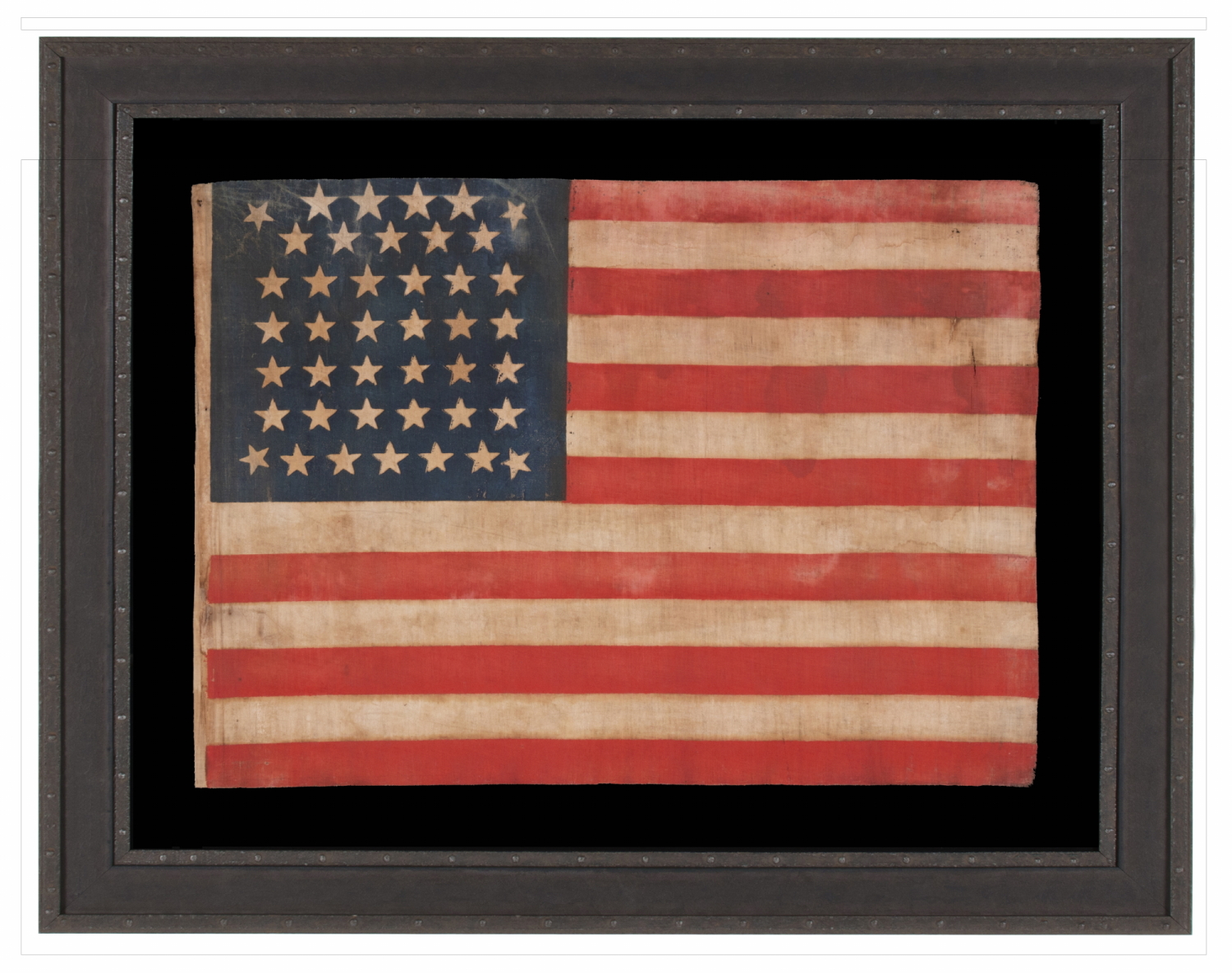
| |
42 STAR ANTIQUE AMERICAN PARADE FLAG WITH AN EXTRAORDINARILY RARE BEEHIVE CONFIGURATION, NEVER AN OFFICIAL STAR COUNT, WASHINGTON STATEHOOD, 1889-1890 |
|
| Available: |
Sold |
| Frame Size (H x L): |
29.5" x 37.5" |
| Flag Size (H x L): |
19.5" x 27.5" |
|
| Description....: |
|
42 star American national parade flag, printed on cotton, with an exceptionally unusual and graphically intriguing feature, and beautiful presentation. The stars of the flag are arranged in a very peculiar fashion that I have termed a “beehive.” I have encountered this and similar patterns on a tiny handful of mid-late 19th century examples, made in an era when there was no official star pattern for the Stars & Stripes.
The particular design present in this flag consists of 7 rows of stars, all pointing upward, that form the a beehive-like profile. Outside this are 4 additional, smaller stars, placed one in each corner, canted at 45 degrees. In the combined image that these create, the lower 2 of the outlier stars either help form the base of the hive, or all 4 outliers may represent to worker bees. In both number and position, these most certainly reflect the 4 remaining Western Territories that had yet to be added.
Note how the 4 stars in the top row are larger than all of the rest. These reflect the 4 new states that had just joined the Union in a 10-day period, from November 2nd – November 11th, 1889, including North & South Dakota, Montana, and Washington State. This was the largest number of states to come in, in such a small amount of time, in American history following the 13 colonies.
A universal symbol of hard work and industry, the beehive is not such an unusual element to incorporate in American flag design as it may, at first glance, appear. Numerous representations of beehives appear in Revolutionary War era flags, and the ideals it signifies were at the heart of not only the diligence inherent to settlers and the colonization of America, but westward expansion and the rapid improvements in the manufacturing sector taking place during the late 19th century, when this flag was made.
The 42 star flag is interesting from a historical perspective, both because 42 was never an official star count, and because 42 star flags were only produced for about 8 months (November, 1889 – July 4th, 1890). The flag represents the addition of the Dakotas, Montana and Washington State, between November 2nd and November 11th, 1889. The 42nd state was officially Washington, but the four states gained their statehood only nine days apart, and flag makers added 4 stars, accordingly, to the count of 38 that was official at the time.
After 1818, star counts became official on the 4th of July each year. A new star was therefore officially added on Independence Day for every state that had been added over the preceding “flag year”. Flag makers, however, did not wait for July 4th and official star counts. Flag production was a competitive industry and no one wanted to be making 38 star flags, for example, when their competitors were making 42 star examples and there were 42 states.
Idaho joined the Union on July 3rd, 1890, taking the star count to 43 just one day before 42 would have become the official number. This fact makes 42 star flags an interesting part of our heritage and a classic display of American capitalism.
Due to a combination of the exceptionally rare and interesting star pattern and the endearing wear, this a tremendous example for any collection or one-time buyer alike. The overall presentation of the flag is simply beautiful.
Mounting: The flag was mounted and framed within our own conservation department, which is led by expert staff. We take great care in the mounting and preservation of flags and have framed thousands of examples.
The flag has been hand-stitched to 100% cotton twill, black in color, which was washed and treated for colorfastness. The black-painted, hand-gilded and distressed molding is Italian. The glazing is U.V. protective plexiglass.
Condition: There is modest soiling throughout. There is significant pigment loss in the top stripe, accompanied by modest areas of loss at the end of the 2nd red stripe, across the 5th red stripe, and in the canton, and very minor losses elsewhere. There is some fabric loss in the white area along the hoist, running approximately 2/5’s of the distance from the bottom up. Fabric of similar coloration was placed behind this area for masking purposes. There is a small tack hole near the top of the hoist end, where the flag was once affixed to its original wooden staff. There is a scattering of tiny holes near the end of the 1st white stripe and three vertical splits, including one in the 2nd white stripe, one spanning from that same stripe to the red one below it, and one spanning from the 4th red stripe into the white one below it. There is some fraying with associated loss at and adjacent to the fly end. Many of my clients prefer early flags to show their age and history of use. |
|
|
|
| Collector Level: |
Advanced Collectors and the Person with Everything |
|
| Flag Type: |
Parade flag |
|
| Star Count: |
42 |
|
| Earliest Date of Origin: |
1889 |
|
| Latest Date of Origin: |
1890 |
|
| State/Affiliation: |
Washington |
|
| War Association: |
1866-1890 Indian Wars |
|
| Price: |
SOLD |
|
| |
Views: 1516 |
|
|
|

